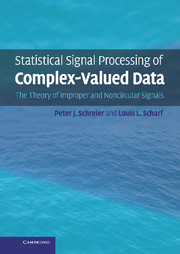Book contents
- Frontmatter
- Contents
- Preface
- Notation
- Part I Introduction
- Part II Complex random vectors
- Part III Complex random processes
- 8 Wide-sense stationary processes
- 9 Nonstationary processes
- 10 Cyclostationary processes
- Appendix 1 Rudiments of matrix analysis
- Appendix 2 Complex differential calculus (Wirtinger calculus)
- Appendix 3 Introduction to majorization
- References
- Index
9 - Nonstationary processes
from Part III - Complex random processes
Published online by Cambridge University Press: 25 January 2011
- Frontmatter
- Contents
- Preface
- Notation
- Part I Introduction
- Part II Complex random vectors
- Part III Complex random processes
- 8 Wide-sense stationary processes
- 9 Nonstationary processes
- 10 Cyclostationary processes
- Appendix 1 Rudiments of matrix analysis
- Appendix 2 Complex differential calculus (Wirtinger calculus)
- Appendix 3 Introduction to majorization
- References
- Index
Summary
Wide-sense stationary (WSS) processes admit a spectral representation (see Result 8.1) in terms of the Fourier basis, which allows a frequency interpretation. The transform-domain description of a WSS signal x(t) is a spectral process ξ(f) with orthogonal increments dξ(f). For nonstationary signals, we have to sacrifice either the Fourier basis, and thus its frequency interpretation, or the orthogonality of the transform-domain representation. We will discuss both possibilities.
The Karhunen–Loève (KL) expansion uses an orthonormal basis other than the Fourier basis but retains the orthogonality of the transform-domain description. The KL expansion is applied to a continuous-time signal of finite duration, which means that its transform-domain description is a countably infinite number of orthogonal random coefficients. This is analogous to the Fourier series, which produces a countably infinite number of Fourier coefficients, as opposed to the Fourier transform, which is applied to an infinite-duration continuous-time signal. The KL expansion presented in Section 9.1 takes into account the complementary covariance of an improper signal. It can be considered the continuous-time equivalent of the eigenvalue decomposition of improper random vectors discussed in Section 3.1.
An alternative approach is the Cramér–Loève (CL) spectral representation, which retains the Fourier basis and its frequency interpretation but sacrifices the orthogonality of the increments dξ(f). As discussed in Section 9.2, the increments dξ(f) of the spectral process of an improper signal can have nonzero Hermitian correlation and complementary correlation between different frequencies.
Information
- Type
- Chapter
- Information
- Statistical Signal Processing of Complex-Valued DataThe Theory of Improper and Noncircular Signals, pp. 223 - 249Publisher: Cambridge University PressPrint publication year: 2010
